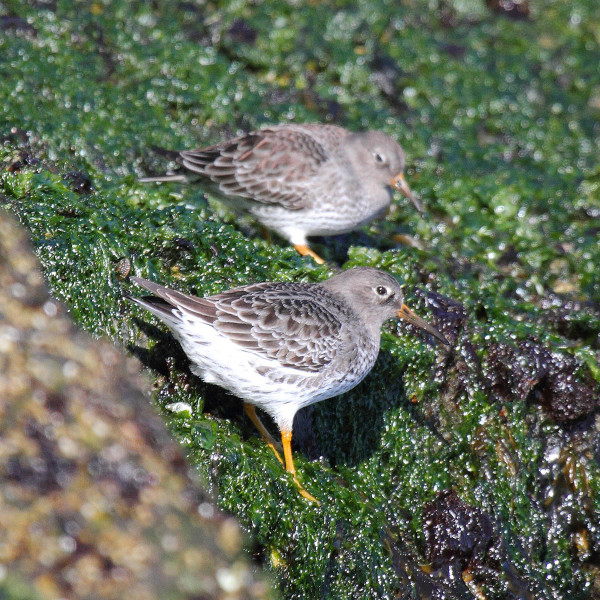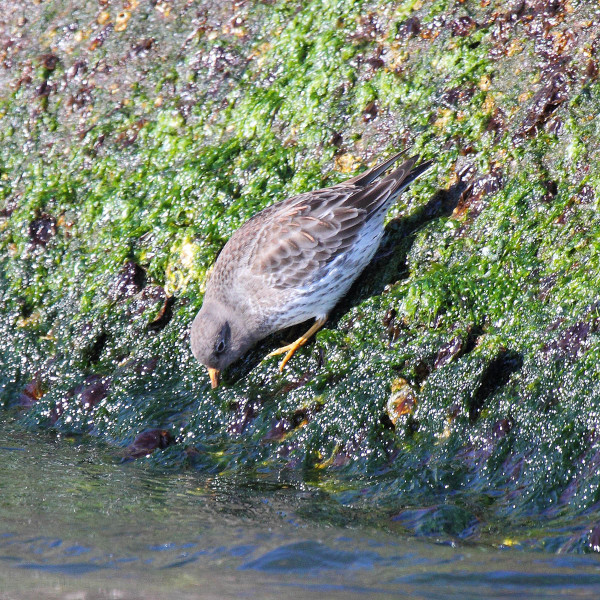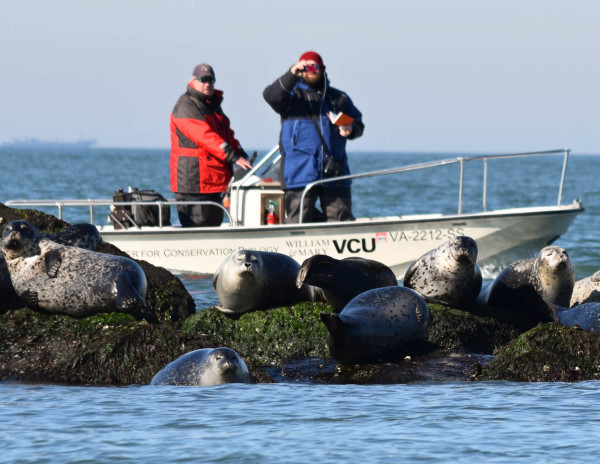Searching for Purples
Grace Returns to Alligator River NWR 1/28/2015
January 29, 2015
Grace Returns to Tidewater Research Station 1/31/2015
February 1, 2015
It was one of those magical days when the winds are light, the water feels like silk under the boat and you can’t see where the Bay ends and the sky begins. You have the sensation of speeding into a featureless wall of blue. Like riding a sled through fog on an icy hill, you enter the sublime and all time begins to bend and then fades away into blueness. A simple delight that more than makes up for the many poor-weather days in the field.

Marian Watts pilots a boat on a cold, clear and calm day toward the Monitor Merrimac Bridge in the mouth of the James River. Photo by Bryan Watts.
Purple sandpipers are different. When other sandpiper species migrate to tropical latitudes, they stubbornly overwinter along the frigid waters of the North Atlantic. The bulk of the population moves south just beyond the arctic ice, with birds remaining along the coasts of Newfoundland, Greenland and Iceland. While other shorebirds forage on sandy beaches, mudflats and marshes, they cling to rocks, dodging and weaving through crevices to pluck mollusks and crustaceans from slimy surfaces, escaping just as the next wave surges over. In winter they inhabit the raw, rocky coastline, a rugged habitat where we would like to be if only for a brief visit.

Two purple sandpipers foraging within the intertidal algae on rocks of the Chesapeake Bay Bridge Tunnel Island. Photo by Bart Paxton.
In part because they breed in such remote locations and winter in situations beyond easy human reach, our information on population status is incomplete. Recent estimates of birds wintering along the Western Atlantic fall around 16,000 individuals but may be twice that number. A recent analysis of trends suggests that the North American population may be declining.
The rocky coastline preferred by the purple sandpiper extends south only to New York. This is the position where the fall line (rocky formation that separates the piedmont from the coastal plain) reaches the coast. South of this location, the coast is comprised of the sandy habitats characteristic of the southern Coastal Plain. In recent centuries, we have used rocks to build islands, jetties, groins and other structures, creating rocky habitats for purple sandpipers and extending their winter range south.

A purple sandpiper probes into the freshly exposed algae for prey. Photo by Bart Paxton.
On January 20, two CCB crews were out on the water to visit the largest of these artificial rock habitats within the Chesapeake Bay. They are rocky islands created to support the entrance of tunnels under the Bay, including the Chesapeake Bay Bridge Tunnel, the Hampton Roads Bridge Tunnel, and the Monitor Merrimac Bridge Tunnel. Because the islands are mostly inaccessible from the bridges, we surveyed the intertidal perimeter for shorebirds by boat.

Seals lounge on the rocks as Bart Paxton (left) and Fletcher Smith (right) survey for shorebirds along a rock island of the Chesapeake Bay Bridge Tunnel. Photo by Brian Lockwood.
We know very little about the ecology and population dynamics of purple sandpipers wintering in the mid-Atlantic Coastal Plain. Numbers may vary year to year depending on conditions in the heart of their winter range to the north. We detected only 86 purple sandpipers along more than 7 kilometers of rocky shoreline. The survey provides an initial baseline that may be compared to future surveys to examine interannual variation. In addition to the purples, we also recorded 64 sanderlings, 38 ruddy turnstones, 21 least sandpipers and 1 western sandpiper feeding on the rocks.

A least sandpiper, one of the other four species detected during the survey, forages within the algae zone of the rocks. Photo by Bryan Watts.
Written by Bryan Watts | bdwatt@wm.edu | (757) 221-2247
January 29, 2015



